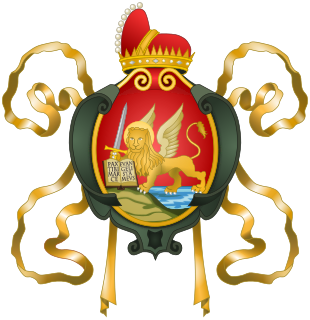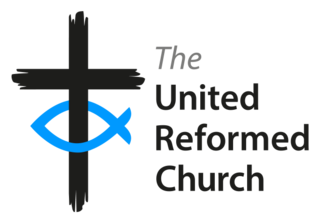The Synod (or Council) of Erfurt was a church council held at Erfurt in northeastern Thuringia under the presidency of Henry I of Germany in 932.

A synod is a council of a church, usually convened to decide an issue of doctrine, administration or application. The word synod comes from the Greek σύνοδος (sýnodos) meaning "assembly" or "meeting", and it is synonymous with the Latin word concilium meaning "council". Originally, synods were meetings of bishops, and the word is still used in that sense in Catholicism, Oriental Orthodoxy and Eastern Orthodoxy. In modern usage, the word often refers to the governing body of a particular church, whether its members are meeting or not. It is also sometimes used to refer to a church that is governed by a synod.

Erfurt is the capital and largest city in the state of Thuringia, central Germany.

Thuringia, officially the Free State of Thuringia, is a state of Germany.
Erfurt was attended by ecclesiastics from every region of the Kingdom of Germany save the Duchy of Bavaria, where Duke Arnulf presided over the Synod of Dingolfing, probably in concert with Henry's simultaneous Erfurt event. The purpose of the synod was to deal with everyday church matters, but it did discuss one pressing issue, that of the annual tribute owed to the Magyars during a nine-year truce (beginning 926). The synod agreed to cease paying the tribute and the Battle of Riade precipitated.

The Kingdom of Germany or German Kingdom developed out of Eastern Francia, the eastern division of the former Carolingian Empire, over the 9th to 11th centuries. East Francia was formed by the Treaty of Verdun in 843, and was ruled by the Carolingian dynasty until 911, after which the kingship was elective. The initial electors were the rulers of the stem duchies, who generally chose one of their own. After 962, when Otto I was crowned emperor, East Francia formed the bulk of the Holy Roman Empire along with Italy; it later included Bohemia and Burgundy.

The Duchy of Bavaria was a frontier region in the southeastern part of the Merovingian kingdom from the sixth through the eighth century. It was settled by Bavarian tribes and ruled by dukes (duces) under Frankish overlordship. A new duchy was created from this area during the decline of the Carolingian Empire in the late ninth century. It became one of the stem duchies of the East Frankish realm which evolved as the Kingdom of Germany and the Holy Roman Empire.
Arnulf, also known as the Bad or the Evil, a member of the Luitpolding dynasty, held the title of a Duke of Bavaria from about 907 until his death in 937.
Among the other issues the synod considered was that brought forward by Pietro Candiano II, Doge of Venice, who suggested in a letter to the council that all Jews who refused to be baptised be expelled from the kingdom.

The Doge of Venice, sometimes translated as Duke, was the chief magistrate and leader of the Republic of Venice between 726 and 1797.

Jews or Jewish people are an ethnoreligious group and a nation, originating from the Israelites and Hebrews of historical Israel and Judah. Jewish ethnicity, nationhood, and religion are strongly interrelated, as Judaism is the traditional faith of the Jewish people, while its observance varies from strict observance to complete nonobservance.
The canons of the council were published as a breviarium canonum and sent to Adalbert, Archbishop of Salzburg.
Canon law is a set of ordinances and regulations made by ecclesiastical authority, for the government of a Christian organization or church and its members. It is the internal ecclesiastical law, or operational policy, governing the Catholic Church, the Eastern Orthodox and Oriental Orthodox churches, and the individual national churches within the Anglican Communion. The way that such church law is legislated, interpreted and at times adjudicated varies widely among these three bodies of churches. In all three traditions, a canon was originally a rule adopted by a church council; these canons formed the foundation of canon law.

Pope Alexander III, born Roland of Siena, was Pope from 7 September 1159 to his death in 1181.
The Synod of Whitby in 664 was a Northumbrian synod where King Oswiu of Northumbria ruled that his kingdom would calculate Easter and observe the monastic tonsure according to the customs of Rome, rather than the customs practised by Irish monks at Iona and its satellite institutions. The synod was summoned at Hilda's double monastery of Streonshalh (Streanæshalch), later called Whitby Abbey.

The United Reformed Church (URC) is a Protestant Christian church in the United Kingdom. It has approximately 56,000 members in 1,400 congregations with 608 active ministers, including 13 church related community workers.
The Evangelical Lutheran Church in America (ELCA) is a mainline Protestant Lutheran Church headquartered in Chicago, Illinois. The ELCA officially came into existence on January 1, 1988, by the merging of three Lutheran church bodies. As of 2017, it has approximately 3.5 million baptized members in 9,163 congregations. In 2015, Pew Research estimated that 1.4 percent of the U.S. population self-identifies with the ELCA. It is the seventh-largest religious body and the largest Lutheran denomination in the United States. The next two largest Lutheran denominations are the Lutheran Church–Missouri Synod (LCMS) and the Wisconsin Evangelical Lutheran Synod (WELS). There are also many smaller Lutheran church bodies in the United States, some of which came into being composed of dissidents following the major 1988 merger. The ELCA belongs to the World Council of Churches and the Lutheran World Federation. The ELCA is in full communion with the Episcopal Church, Moravian Church, Presbyterian Church (USA), Reformed Church in America, United Church of Christ, and the United Methodist Church.

The International Lutheran Council is a worldwide association of confessional Lutheran denominations. It is to be distinguished from the Lutheran World Federation and the Confessional Evangelical Lutheran Conference. The member church bodies of the ILC are not required to be in church-fellowship with one another, though many of them are. The organization was constituted in 1993 at a council held in Antigua, Guatemala, although it traces its roots back to theological conferences held in many locations during the 1950s and 1960s.

The Moravian Church, formally named the Unitas Fratrum, in German known as [Herrnhuter] Brüdergemeine, is one of the oldest Protestant denominations in the world, with its heritage dating back to the Bohemian Reformation in the 15th century and the Unity of the Brethren established in the Kingdom of Bohemia.
Victor IV was elected as a Ghibelline antipope in 1159, following the death of Pope Adrian IV and the election of Alexander III. His election was supported by the Emperor Frederick Barbarossa. He took the name Victor IV, not accounting for Antipope Victor IV of 1138, whose holding of the papal office was deemed illegitimate.
Nothhelm was a medieval Anglo-Saxon Archbishop of Canterbury. A correspondent of both Bede and Boniface, it was Nothhelm who gathered materials from Canterbury for Bede's historical works. After his appointment to the archbishopric in 735, he attended to ecclesiastical matters, including holding church councils. Although later antiquaries felt that Nothhelm was the author of a number of works, later research has shown them to be authored by others. After his death he was considered a saint.
Cuthbert was a medieval Anglo-Saxon Archbishop of Canterbury in England. Prior to his elevation to Canterbury, he was abbot of a monastic house, and perhaps may have been Bishop of Hereford also, but evidence for his holding Hereford mainly dates from after the Norman Conquest of England in 1066. While Archbishop, he held church councils and built a new church in Canterbury. It was during Cuthbert's archbishopric that the Diocese of York was raised to an archbishopric. Cuthbert died in 760 and was later regarded as a saint.

The Councils of Carthage, or Synods of Carthage, were church synods held during the 3rd, 4th, and 5th centuries in the city of Carthage in Africa. The most important of these are described below.
The Evangelical Synod of North America, before 1927 German Evangelical Synod of North America, in German (Deutsche) Evangelische Synode von Nord-Amerika, was a Protestant Christian denomination in the United States existing from the mid-19th century until its 1934 merger with the Reformed Church in the United States to form the Evangelical and Reformed Church. This church merged with the Congregational Christian Churches denomination in 1957 to create the United Church of Christ.

Old Lutherans were originally German Lutherans in the Kingdom of Prussia, notably in the Province of Silesia, who refused to join the Prussian Union of churches in the 1830s and 1840s. Prussia's king Frederick William III was determined to unify the Protestant churches, to homogenize their liturgy, organization and even their architecture. In a series of proclamations over several years the Church of the Prussian Union was formed, bringing together the majority group of Lutherans, the minority of Reformed. The main effect was that the government of Prussia had full control over church affairs, with the king recognized as the leading bishop.

The Battle of Riade or Battle of Merseburg was fought between the troops of East Francia under king Henry I and the Magyars at an unidentified location in northern Thuringia along the river Unstrut on 15 March 933. The battle was precipitated by the decision of the Synod of Erfurt to stop paying an annual tribute to the Magyars in 932.
A legatine council or legatine synod is an ecclesiastical council or synod that is presided over by a papal legate.

Henry V was King of Germany and Holy Roman Emperor, the fourth and last ruler of the Salian dynasty. Henry's reign coincided with the final phase of the great Investiture Controversy, which had pitted pope against emperor. By the settlement of the Concordat of Worms, he surrendered to the demands of the second generation of Gregorian reformers.

Henry IV became King of the Germans in 1056. From 1084 until his forced abdication in 1105, he was also referred to as the King of the Romans and Holy Roman Emperor. He was the third emperor of the Salian dynasty and one of the most powerful and important figures of the 11th century. His reign was marked by the Investiture Controversy with the Papacy, and he was excommunicated five times by three different popes. Civil wars over his throne took place in both Italy and Germany. He died of illness, soon after defeating his son's army near Visé, in Lorraine, France.

St. Augustine's Monastery in Erfurt in central Germany, is a former church and monastery complex dating from the 13th century. The site is almost one hectare in size. It was built by Augustinian monks, an order of the Catholic Church. It is most well known as the former home of Martin Luther (1483-1546), the father of the Reformation, who lived there as a monk from 1505 until 1511.

Petersberg Citadel in Erfurt, central Germany, is one of the largest
and best preserved town fortresses in Europe. The citadel was built on Petersberg hill, in the north-western part of the old town centre from 1665, when Erfurt was governed by the Electorate of Mainz. It is surrounded by over two kilometres of stone walls and is 36 hectares in size.

















